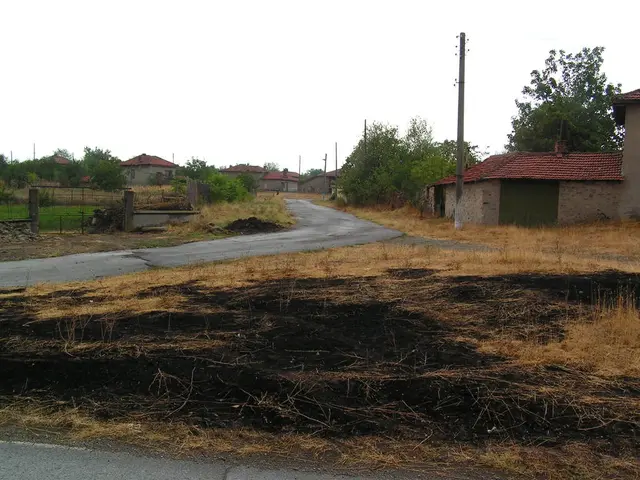Explore Ahead: Hidden Gems Unveiled in Acadia National Park
Prepare for an epic adventure at Acadia National Park, the unparalleled jewel of the North Atlantic coast! This unique nirvana blends ocean and mountains in a breathtaking fusion, draped in lush evergreen forests that cascade from craggy granite peaks onto miles of rugged coastline. Get pumped for an unforgettable journey through one of the most diverse landscapes in the National Park system!
With 3.5 million visits annually, Acadia ranks as one of the most popular national parks, yet it's also one of the tiniest with just 49,052 acres of protected lands-that's only a smidgen compared to Grand Teton National Park. So, buckle up for a one-of-a-kind experience!
Most action takes place on Mount Desert Island (MDI), sharing space with island communities like Bar Harbor, Southwest Harbor, Northeast Harbor, and Mount Desert. The park's lands also span Schoodic Peninsula across Frenchman Bay to the east, Isle au Haut, and several outer islands to the south.
For the smoothest sailing on the eastern side, hop onto the 27-mile Park Loop Road. This scenic drive delivers constant ocean views and cover most hotspots, including the extensive carriage road system, the island's highest peak (Cadillac Mountain), and the only sandy beaches (Sand Beach and Echo Lake Beach).
For a more untamed experience, explorers can head west, known as "the quiet side," which gets far fewer visitors. Here you'll find fewer carriage roads, but it's otherwise identical to the east side. Trails pass through dense forest to reach open ridgelines and rugged peaks. There's also less foot traffic, allowing for a genuine sense of wilderness. The coastline may not be as dramatic, but it more than makes up for it when you've got the whole view to yourself.
Timing your visit is crucial, especially during peak season (June to August) when it can get crowded. But don't let that deter you—Acadia is worth a visit any time of year. For insider tips on avoiding the crowds and making the most of your trip, read on!
Acadia embraces every season, and there's always something to do, whether you're a fan of hiking, biking, paddling, or stargazing. Here's how to make the most of your visit whenever you go.
Spring: Be prepared for the unexpected! Temperatures range from the 30s to the 70s Fahrenheit, and you may experience everything from warm and sunny days to spitting snow and ice. It's also windy and possibly muddy. A sweet spot lies in mid- to late-April, when Park Loop Road reopens, but the crowds haven't arrived. Be aware that surrounding towns may not be fully reopened until Memorial Day weekend, so accommodations and food options will be limited.
Summer: Gear up for traffic during the busiest season, particularly on holiday weekends, when Park Loop Road clogs and parking becomes scarce. Fill up the gas tank as there are no service stations within the park. To avoid the crowds, visit before 8 a.m. or after 5 p.m. Start your day with a spin down Park Loop Road for coastal views of Otter Point, Sand Beach, and Thunder Hole. Spend the rest of the day exploring hiking, paddling, or biking trails before hitting the lunch rush at Jordan Pond House, known for its famous popovers.
Fall: Pack your bags for idyllic conditions! It's less crowded, less hot, fewer bugs, and just about as perfect as it gets. The air is crystal clear, offering amazing stargazing, especially in the summer when the Milky Way is at its brightest. By mid-October, the fall foliage peaks, and the surrounding forests display stunning hues. Coastal bird migration routes bring millions of songbirds and raptors to the region, making it a bird lover's paradise. To keep tabs on the foliage, check Maine's fall foliage tracker.
Winter: Acadia quiets down as many hotels, restaurants, and shops close for the season. Start cross-country skiing or snowshoeing as soon as there's enough snow on the carriage roads or even on the sections of Park Loop Road closed to cars. Watch out for snowmobiles! The lack of light pollution allows for spectacular night skies, and you can even catch a glimpse of the northern lights. Check NOAA's aurora forecaster to see if it's a good night to try your luck.
Always be prepared for rain showers or windy days while in Acadia, and pack plenty of layers. Trek through April's sweet spot with a park entrance pass in hand, which you can even grab in advance! The current fee is $30 per vehicle, and the pass is valid for seven days. Discounted passes are available for motorcyclists and pedestrians.
When visiting, be aware that unlike many other national parks, there aren't always hard boundaries between park land and private property. Show respect for local communities and be patient. If you're new to the park, visit one of the visitor centers to get help with navigating trails, gear up, and tap into local expertise.
Hiking in Acadia:
Eastern Mount Desert Island hosts some of the park's most popular hiking trails. For sea views and pink granite formations, take Ocean Path between Sand Beach and Otter Point. For peak baggers and sunrise chasers, tackle Cadillac Mountain (1,530 ft.), the island's highest point, but secure a reservation to drive to the summit. Adventurous souls can traverse sheer cliff faces and narrow ledges using ladders and steels rungs on Precipice Trail and Beehive, taking in breathtaking ocean views along the way.
Bar Island Trail is a popular but seasonal hike accessible only during low tide. Explore a narrow gravel bar between Bar Harbor and Bar Island, where steam rises off the rocks in the winter for a sea of fog effect. Just be sure to wear crampons since the rocks can be slippery, and check the tide chart before you set off.
For a more peaceful hike, try Hunter's Beach Trail, an easy, family-friendly hike to an isolated cove with a cobblestone beach. Compress Harbor Trail takes you through dense forest to an abandoned estate and a granite outcrop with incredible views. For a shorter but wildly intense peak bag with view after view, conquer the Bald Peak, Parkman Mountain, Gilmore Mountain, and Sargent Mountain Loop.
Cycling in Acadia:
Rev your engine for the 45-mile network of carriage roads that weave around the east side's mountains and valleys. These picturesque roads boast a magnificent system of bridges and mountain vistas, with clear signage at intersections for easy navigation. You'll share the roads with horses and pedestrians, but only Class-1 e-bikes are allowed. Be aware that some carriage roads close in spring due to muddy conditions, so check posted signs and notices for updates.
Biking options are lighter on the western side, but there are still options for every experience level, with opportunities for pure adrenaline rides that test your strength and endurance. Grab a rental if you don't have your own bike.
Paddling in Acadia:
Lace up your paddling boots and set sail on one of Acadia's quiet inland waters, offering fantastic bird and wildlife watching opportunities. Be on the lookout for loons, ducks, bald eagles, osprey, and even otters. Savor breathtaking views of Jordan Cliffs on the east face of Penobscot Mountain from Jordan Pond, or admire the views of Cadillac and Pemetic Mountain on Eagle Lake.
Remember to familiarize yourself with Leave No Trace principles to minimize your impact on the park, and be mindful of private property boundaries when exploring the local communities. Make the most of your visit to Acadia and enjoy the unrivaled beauty awaiting you on the coast!
Exploring Acadia National Park transcends typical recreational activities, integrating travel, sports, and lifestyle in a unique fashion. While immersed in the park, one can participate in sports such as hiking, biking, and paddling, offering an exhilarating travel experience. For sports enthusiasts, the park provides analysis of difficult trails like Precipice Trail and Beehive, demanding a combination of physical prowess and mental stamina.
Furthermore, Acadia National Park has diversified sports offerings for every visitor, even introducing the concept of paddling on the park's inland waters for an unparalleled wildlife viewing opportunity. By embracing these various sports activities, an adventurer can enhance their overall lifestyle and truly appreciate the breathtaking landscapes of Acadia.








